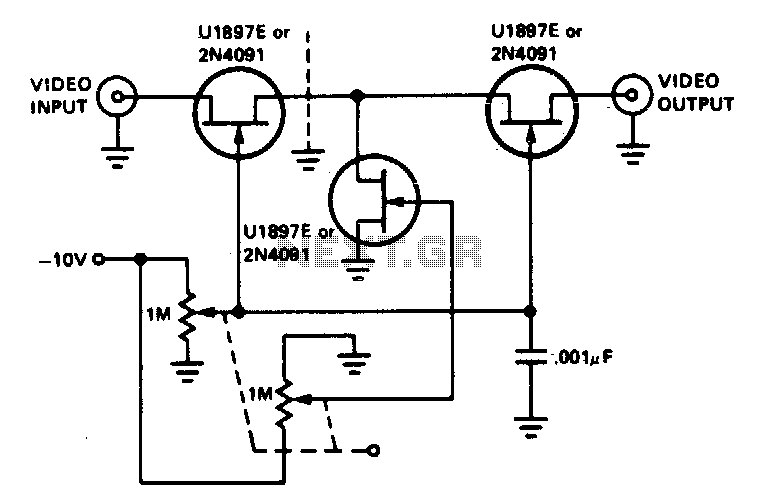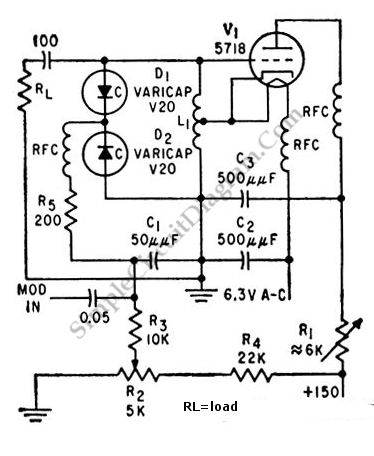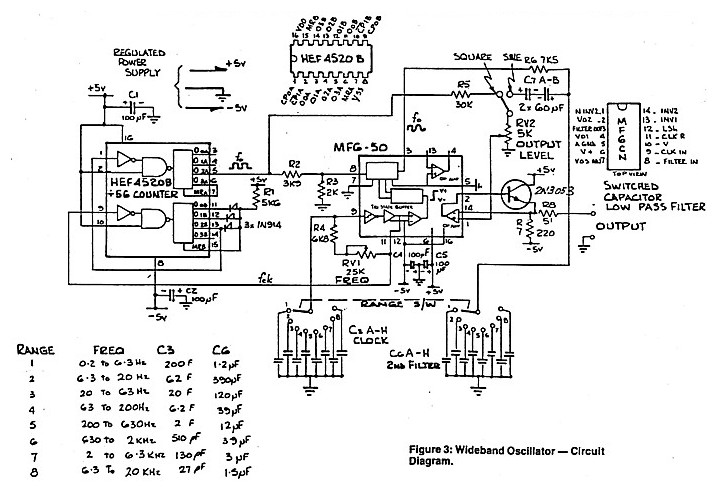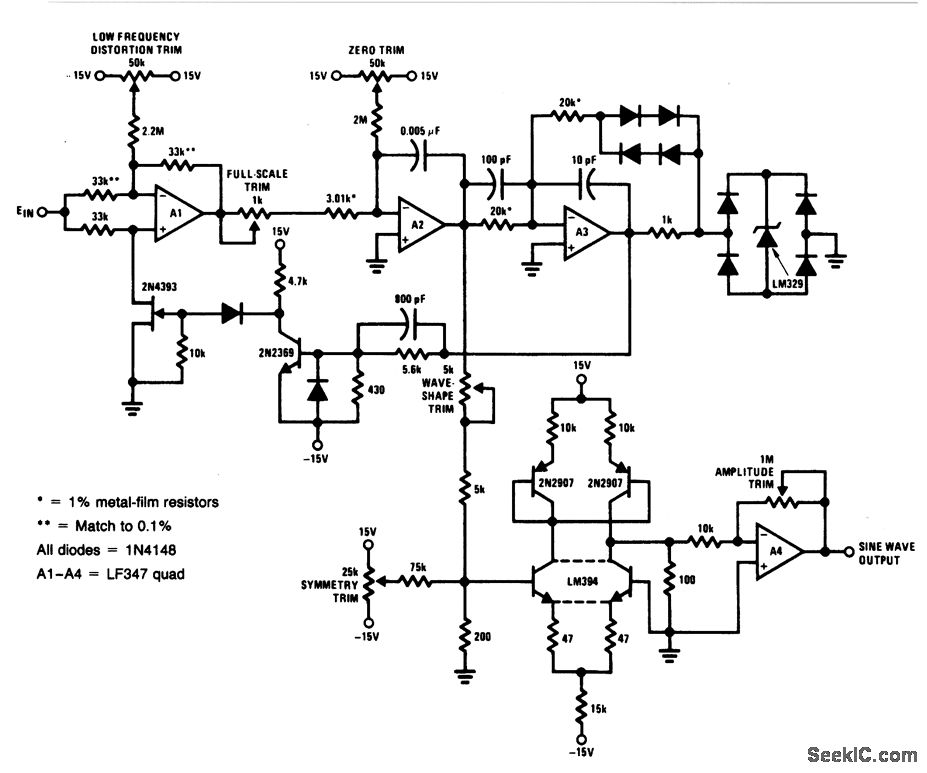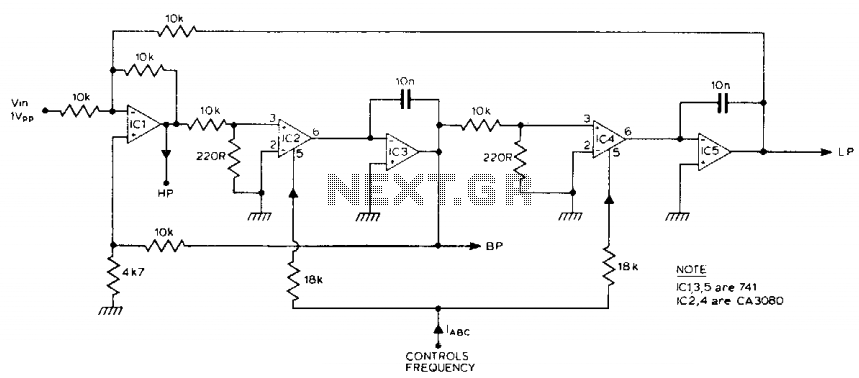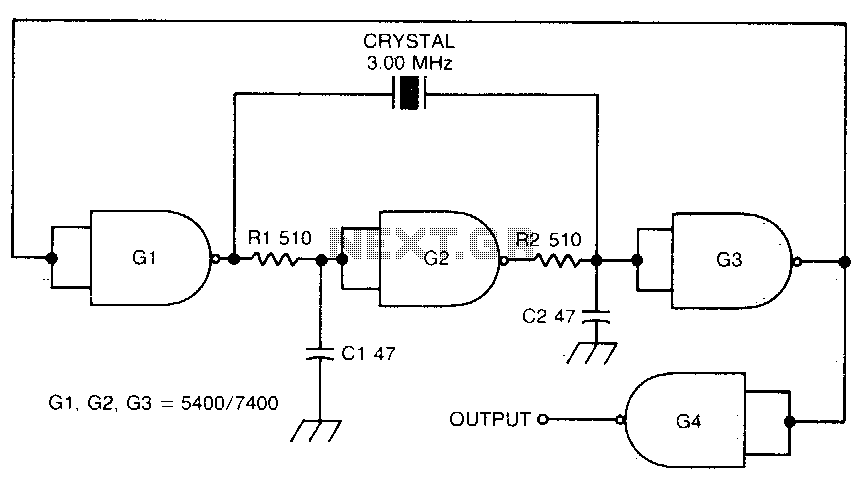
State Variable Oscillator
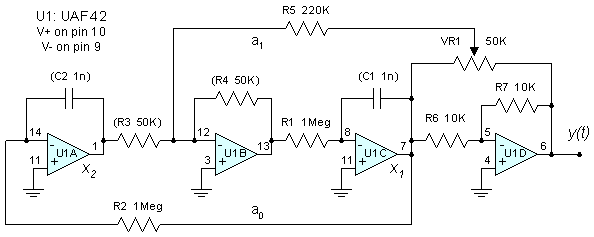
The major functional blocks necessary for designing a general-purpose audio oscillator are outlined, along with the details of the current prototype. The implementation is in the mode of an analog computer, as the desired outputs are sine and cosine values as functions of time. A snapshot shows the prototype connected to an X-Y oscilloscope to display a Lissajous pattern. The circle on the oscilloscope indicates a nearly perfect 90-degree phase shift between the sine and cosine outputs, which maintains this quadrature relationship across the oscillator's frequency range. The fascination with oscillators stems from past experiences where many breadboards oscillated unexpectedly. Additionally, when attempting to create an oscillating circuit, it often seems to behave unpredictably. Several authors, including Bob Metzler and Don Lancaster, identify the state variable oscillator as the preferred circuit for generating low-distortion sine waves for audio applications. Although these authors do not provide implementation details, a reference to the article "Design for a Low-Distortion, Fast-Settling Source" in the August 1980 issue of the Hewlett-Packard Journal describes the internal workings of the HP8903A Audio Measurement System, including schematic sketches. This information has facilitated the development of a detailed analysis. The required electronic circuit is a simple analog computer featuring two integrators and a summer, as depicted in the simulation diagram. The integrator outputs are labeled with the state variables x1 and x2. This circuit is adapted from an application note for the Burr-Brown UAF42 state variable filter. The pin numbers correspond to the UAF42, which was selected for its precision integrator capacitors and availability from Digi-Key. Other manufacturers, such as Analog Devices, also offer similar analog function circuits. The circuit can be breadboarded using any available operational amplifiers and capacitors. Parts values within parentheses are specific to the UAF42 and would need to be replaced with discrete components if alternative operational amplifiers are used. Operational amplifiers such as the TL082 and LF353 exhibit performance characteristics similar to the UAF42. With the specified parts values, the circuit will oscillate at approximately 160 Hz when the damping factor is set slightly negative with VR1. Restoring the damping factor to zero (VR1 near the center of its range) maintains steady oscillation. Using a 10-turn potentiometer for VR1 allows for sufficient stabilization of output amplitude to facilitate quick distortion measurements. Assuming operation is not at or near clipping, harmonic distortion will be negligible. Following the demonstration of the basic concept, it is essential to consider the attributes desired for a general-purpose audio oscillator. A table lists design goals alongside actual results measured from the prototype, with spectra plotted at 10 dB/division on the vertical axis using an HP3580A. Achieving these goals is complex. While a light bulb symbolizes innovation, achieving the stated objectives necessitates more than a simple solution. Given the analog computation approach, the inclusion of a closed-loop control system is proposed to maintain stable sine wave oscillation. A Detector and a Proportional/Integral (PI) Controller have been integrated into the oscillator. In some literature, these components are referred to as the Sensor, the Compensator, and the Plant, respectively. The only additional component required is an error detector, represented below as a summer generating an error voltage, which is the difference between a reference voltage.
The described audio oscillator circuit utilizes a state variable design, which is well-suited for generating low-distortion sine and cosine waveforms. The architecture consists of two integrators, which perform the mathematical integration necessary for generating the sine and cosine outputs. The summer combines the outputs of the integrators to produce the required waveforms, while the feedback loop ensures stability and control over the oscillation characteristics.
The use of the Burr-Brown UAF42 state variable filter is significant due to its integrated precision components, which enhance the performance and reliability of the oscillator. The circuit's design allows for easy adjustments via the variable resistor VR1, which modifies the damping factor to achieve the desired oscillation frequency and amplitude.
The implementation of a closed-loop control system with a PI Controller further enhances the oscillator's performance by continuously adjusting the output to minimize error, thus maintaining consistent waveform characteristics. This approach is particularly advantageous in applications requiring precise signal generation, such as audio synthesis and testing.
In summary, the combination of a state variable oscillator design, precision components, and a control system results in a robust and versatile audio oscillator capable of producing high-quality sine and cosine waveforms across a specified frequency range. The detailed analysis and implementation considerations provide a solid foundation for further development and experimentation in audio oscillator design.The major functional blocks necessary to design a general purpose audio oscillator, and give all the details of my current prototype. Implementation is in the mode of an analog computer, since the desired outputs are sine and cosine values as a function of time.
The following snapshot shows my prototype connected to an X-Y oscilloscope, to display a Lissajous pattern. The circle shown on the scope indicates a nearly perfect 90 degree phase shift between sine and cosine outputs. This quadrature relationship is maintained across the frequency range of the oscillator. I`ve always been fascinated by oscillators, because so many of my past breadboards oscillated but shouldn`t have.
And even when I want a circuit to oscillate, it often seems to be out of control. I have found that a number of authors, including Bob Metzler 1 and Don Lancaster 2, identify the state variable oscillator as the circuit of choice for generating low distortion sine waves for audio use. These authors don`t show the details of how to implement such a circuit, but luckily one day while surfing the web I came across a reference to the article "Design for a Low-Distortion, Fast-Settling Source" in the August 1980 issue of the Hewlett-Packard Journal 3.
That article describes the internal workings of the HP8903A Audio Measurement System, including sketch schematics. Based on this information, I have been able to develop the following analysis. The electronic circuit needed to satisfy this equation is a simple analog computer having two integrators and a summer, as shown in this simulation diagram.
The integrator outputs are identified by the state variables x1 and x2. This circuit is paraphrased from an excellent application note 4 for the Burr-Brown UAF42 state variable filter. Pin numbers shown are for the UAF42, which I used because it contains precision integrator capacitors, and because it is easily available from Digi-Key.
Burr-Brown isn`t the only source for analog function circuits. Analog Devices also has a similar line of parts which is available through distribution. Of course, you can breadboard this with any old opamps and capacitors you happen to have available. Parts values shown in parentheses are internal to the UAF42, and would have to be replaced with discrete components if other opamps are used. Opamps like the TL082 and LF353 have performance characteristics similar to the UAF42. With the parts values shown, the circuit will oscillate at around 160 Hz when you set the damping factor slightly negative with VR1.
Restore damping factor to zero (VR1 near center of range) to maintain steady oscillation. If you use a 10-turn potentiometer for VR1, you should be able to stabilize output amplitude enough to make a quick distortion measurement. Assuming you aren`t at or near clipping, harmonic distortion will be so low as to be unmeasureable. Now that we`ve shown that the basic idea works, let`s take a look at what attributes would be desired for a general purpose audio oscillator.
In the following table I list design goals as well as actual results measured on my prototype, shown above. Spectra were plotted with 10 dB/division on the vertical axis, using an HP3580A. Achieving these goals is not trivial. We often think of a light bulb as the symbol for bright ideas and innovation. In this case however, it will take more than a simple light bulb to achieve the stated goals. Since we are in the mode of analog computation, let`s consider the use of a closed loop control system 5 to maintain stable sine wave oscillation.
To do this I`ve added a Detector and a Proportional/Integral (PI) Controller to the Oscillator. In some texts, these blocks would be called the Sensor, the Compensator, and the Plant, respectively. The only additional block needed is an error detector, shown below as a summer producing an error voltage which is the difference between a reference volt
🔗 External reference
The described audio oscillator circuit utilizes a state variable design, which is well-suited for generating low-distortion sine and cosine waveforms. The architecture consists of two integrators, which perform the mathematical integration necessary for generating the sine and cosine outputs. The summer combines the outputs of the integrators to produce the required waveforms, while the feedback loop ensures stability and control over the oscillation characteristics.
The use of the Burr-Brown UAF42 state variable filter is significant due to its integrated precision components, which enhance the performance and reliability of the oscillator. The circuit's design allows for easy adjustments via the variable resistor VR1, which modifies the damping factor to achieve the desired oscillation frequency and amplitude.
The implementation of a closed-loop control system with a PI Controller further enhances the oscillator's performance by continuously adjusting the output to minimize error, thus maintaining consistent waveform characteristics. This approach is particularly advantageous in applications requiring precise signal generation, such as audio synthesis and testing.
In summary, the combination of a state variable oscillator design, precision components, and a control system results in a robust and versatile audio oscillator capable of producing high-quality sine and cosine waveforms across a specified frequency range. The detailed analysis and implementation considerations provide a solid foundation for further development and experimentation in audio oscillator design.The major functional blocks necessary to design a general purpose audio oscillator, and give all the details of my current prototype. Implementation is in the mode of an analog computer, since the desired outputs are sine and cosine values as a function of time.
The following snapshot shows my prototype connected to an X-Y oscilloscope, to display a Lissajous pattern. The circle shown on the scope indicates a nearly perfect 90 degree phase shift between sine and cosine outputs. This quadrature relationship is maintained across the frequency range of the oscillator. I`ve always been fascinated by oscillators, because so many of my past breadboards oscillated but shouldn`t have.
And even when I want a circuit to oscillate, it often seems to be out of control. I have found that a number of authors, including Bob Metzler 1 and Don Lancaster 2, identify the state variable oscillator as the circuit of choice for generating low distortion sine waves for audio use. These authors don`t show the details of how to implement such a circuit, but luckily one day while surfing the web I came across a reference to the article "Design for a Low-Distortion, Fast-Settling Source" in the August 1980 issue of the Hewlett-Packard Journal 3.
That article describes the internal workings of the HP8903A Audio Measurement System, including sketch schematics. Based on this information, I have been able to develop the following analysis. The electronic circuit needed to satisfy this equation is a simple analog computer having two integrators and a summer, as shown in this simulation diagram.
The integrator outputs are identified by the state variables x1 and x2. This circuit is paraphrased from an excellent application note 4 for the Burr-Brown UAF42 state variable filter. Pin numbers shown are for the UAF42, which I used because it contains precision integrator capacitors, and because it is easily available from Digi-Key.
Burr-Brown isn`t the only source for analog function circuits. Analog Devices also has a similar line of parts which is available through distribution. Of course, you can breadboard this with any old opamps and capacitors you happen to have available. Parts values shown in parentheses are internal to the UAF42, and would have to be replaced with discrete components if other opamps are used. Opamps like the TL082 and LF353 have performance characteristics similar to the UAF42. With the parts values shown, the circuit will oscillate at around 160 Hz when you set the damping factor slightly negative with VR1.
Restore damping factor to zero (VR1 near center of range) to maintain steady oscillation. If you use a 10-turn potentiometer for VR1, you should be able to stabilize output amplitude enough to make a quick distortion measurement. Assuming you aren`t at or near clipping, harmonic distortion will be so low as to be unmeasureable. Now that we`ve shown that the basic idea works, let`s take a look at what attributes would be desired for a general purpose audio oscillator.
In the following table I list design goals as well as actual results measured on my prototype, shown above. Spectra were plotted with 10 dB/division on the vertical axis, using an HP3580A. Achieving these goals is not trivial. We often think of a light bulb as the symbol for bright ideas and innovation. In this case however, it will take more than a simple light bulb to achieve the stated goals. Since we are in the mode of analog computation, let`s consider the use of a closed loop control system 5 to maintain stable sine wave oscillation.
To do this I`ve added a Detector and a Proportional/Integral (PI) Controller to the Oscillator. In some texts, these blocks would be called the Sensor, the Compensator, and the Plant, respectively. The only additional block needed is an error detector, shown below as a summer producing an error voltage which is the difference between a reference volt
🔗 External reference
